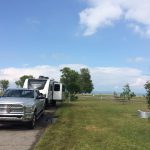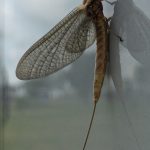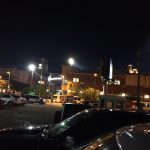It took 55 years, but I finally made it to Michigan.
I’ve visited all the neighboring states, but Michigan sort of hides out among the Great Lakes; it’s not on the way to anywhere, except perhaps Canada. Also, as soon as you cross the border from Indiana a camper is presented with a bit of a problem. Detroit looms at the door to the state like Mr. T in his ill-tempered bouncer days. How would I deal with the challenge of camping in a densely populated, high crime metropolitan area?
I found a loophole in the form of William G Sterling State Park. It is the only Michigan State Park on Lake Erie, and conveniently located just a bit south of the urban octopus that is Detroit. Sterling was an easy day trip from Dearborn, which I planned to visit, and by happy coincidence also near to where an old pal from my online gaming days lives.
Kudos to the Michigan DNR
The real payoff was the park itself turned out to be a very nice introduction to lakeshore camping in Michigan. I now know that most of the State Parks here follow the same basic formula: first if there is a lake nearby, build a campground as close to the water as possible. Grade the area level and plant grass, then pack in campsites every 25 feet. Furnish each with good 30 amp power, a wood & pipe picnic table and a sturdy fire ring made from a two foot tall section of galvanized culvert lined with concrete to protect the fire from the wind. Water freezes in the cold Michigan winters, so limit water taps to a handful of jug filling stations and hose towers at the dump station.
Later I would find that this recipe was copied by most of the city & county parks as well, with the exception that they use a different fire ring vendor and occasionally offered some full hookup sites. Where there was no lake, the State varied the theme a bit by placing the campgrounds in wooded areas. Trails at both kind of parks were excellent, and the shower houses looked to be in good shape though I didn’t need to use them. The only downside I noticed was there were no laundry facilities at any of the Michigan parks, so you have to seek out a laundromat in an adjacent town.
Sterling offered a sandy beach, a coastal birding trail and wide open views of Lake Erie. Along with that view came a plethora of mayflies. Most days they were prevented from doing their flying mating dance by the constant wind, so they sought shelter on the only objects above knee level: the RVs in the campground.
I found the mayflies much less annoying than the gnats, no-see-ums and biting flies I’d encountered down South. They don’t sting, buzz or go after your food as they are too busy living their short lives to bother with humans, so most interactions are purely accidental.
In summary the park made an excellent base camp for me to explore the surrounding area. I had lunch with my friend Brian and his wife and made a couple side trips in the truck. The first was a small taste of Motor City when I braved Interstate traffic to visit the Henry Ford Museum in Dearborn.
A Truck a Minute: Ford Rouge Factory Tour
Henry Ford was a gent with a lot of varied interests other than building cars. Like many of the super-rich of the robber baron era, he indulged these interests by creating projects for the public. Some of these survive today as properties now owned by a charitable foundation. They include a 1900’s life recreation called Greenfield Village and the somewhat random Museum of American Innovation, but the collective offerings now go by the simple title of The Henry Ford. No doubt a full survey would have been rewarding, but between the horrific condition of Detroit highways, construction traffic, rainy weather and arriving in late afternoon I elected to limit myself to what had brought me here – the Ford F-150 factory tour.
Let me preface this by saying I’ve seen a few auto assembly plants before, most notably the Corvette plant in Bowling Green (as a tourist) and the now demolished Pontiac plant in Doraville (as a contractor). While those were both good examples of American car maker efficiency, what Ford has done with their F-150 plant in Dearborn is quite amazing.
What impressed me was not the multimedia theatre, Disney-esque whiz bang pickup truck sales pitch with robotic laser arms or even the fine examples of vintage Ford cars in the mini-museum. All that is window dressing for tourism’s sake. It’s the assembly plant itself that wowed me.
If you’ve ever been in a factory that builds products out of metal, you know they tend to be less than the ideal work environment. Typically such facilities are hot in the summer and cold in the winter. The plant is loud, and the work is often dirty and dangerous. Hence your usual factory worker is required to wear special safety gear like goggles, ear muffs, steel toe shoes and other protective clothing. Line workers have to pay constant attention to their repetitive tasks as management is always urging the line to move faster to meet production schedules.
But when you tour the F150 plant, you’ll see workers wearing shorts, t-shirts and sneakers listening to iPods in a quiet, climate controlled building that is impeccably clean. They move at a seemingly leisurely pace, lifts automatically positioning each vehicle within easy reach, even texting on their phones as they wait for the next truck to come down the line. I’ve never seen anything like it. I hope these UAW workers appreciate how good their jobs are, because I’m retired and I found myself wanting to work there!
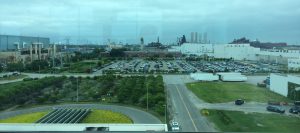
Unfortunately, cameras are forbidden inside the Rouge plant itself, so all I can show you is some exterior shots from the observation deck. Even there though you can see Ford’s innovative thinking, sporting a “green roof” system that addresses carbon emissions, ground water pollution and energy efficiency all at the same time. If you have any interest in manufacturing (even if you drive a Dodge like me) I would recommend taking the Rouge Plant Tour if should find yourself in Detroit. If anything is going to “make America great again”, it is American companies doing things like this.
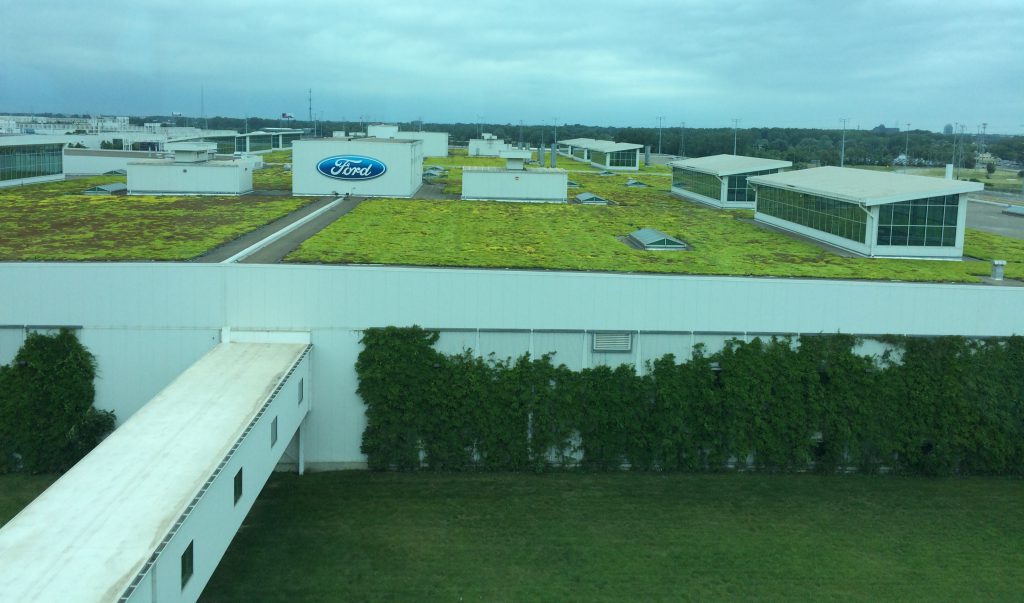
Corporal Klinger’s Hometown: Toledo and the Mud Hens
I decided to stretch my time in the area for an extra day because I had a hankering to catch a baseball game. One trip into Detroit was enough, so I passed on the Tigers and looked around for a minor league game to catch. At first I was thinking about the Lansing Lugnuts, but that was a bit far and off my route. Then the map showed me Toledo was only a half hour away. Even though it meant back tracking into Ohio I decided to go see a Mud Hens game.
Toledo turned out to be kind of neat – an old rust belt town that is reinventing itself by attracting service industries. The Mud Hens play in a nifty park build in 2002 that is right smack downtown on the river. That surprised me a bit because most newer ballparks seem to end up in marginal parts of town, but Fifth Third Field occupies prime real estate. If you worked in Toledo it would be mighty tempting to sneak off for to catch the businessman’s special on a nice spring afternoon. Finding parking was a bit of a challenge, but once I found a lot to tuck Peggy away I joined the throng in the Hensville entertainment district and became a Mud Hens fan for the day.
And a fine evening of baseball it was, too. The Hens were in command for the entire game until the final inning, when a Minor League Moment occurred. One of the realities you must accept as a fan of farm team baseball is that your team’s primary purpose is not to win ball games, but to develop players to be sent up to the Big Show. (In the Mud Hens’ case the Detroit Tigers.) As such the manager will often choose to put his players into pressure situations to see how they handle themselves even if it may cost the team the game.
And so it happened that the Hens’ coach allowed a relief pitcher recruited from the Yokohama league to try to pitch his way out of a tight spot in the ninth inning. Well, Mr. Tazawa wasn’t up to the task that Monday night, so the Mud Hens blew a two run lead to lose to the Indianapolis Indians, 5 to 4.
It didn’t matter to me though, it was still a wonderful night at the ballpark. Life is good, even if the Mud Hens lost and the roads in Detroit are rough as a cob.
Next up: on to the Thumb!
Postscript: Junichi Tazawa’s contract with the Tigers organization was dropped two weeks later. His is currently on the disabled list for the Salt Lake Bees.

